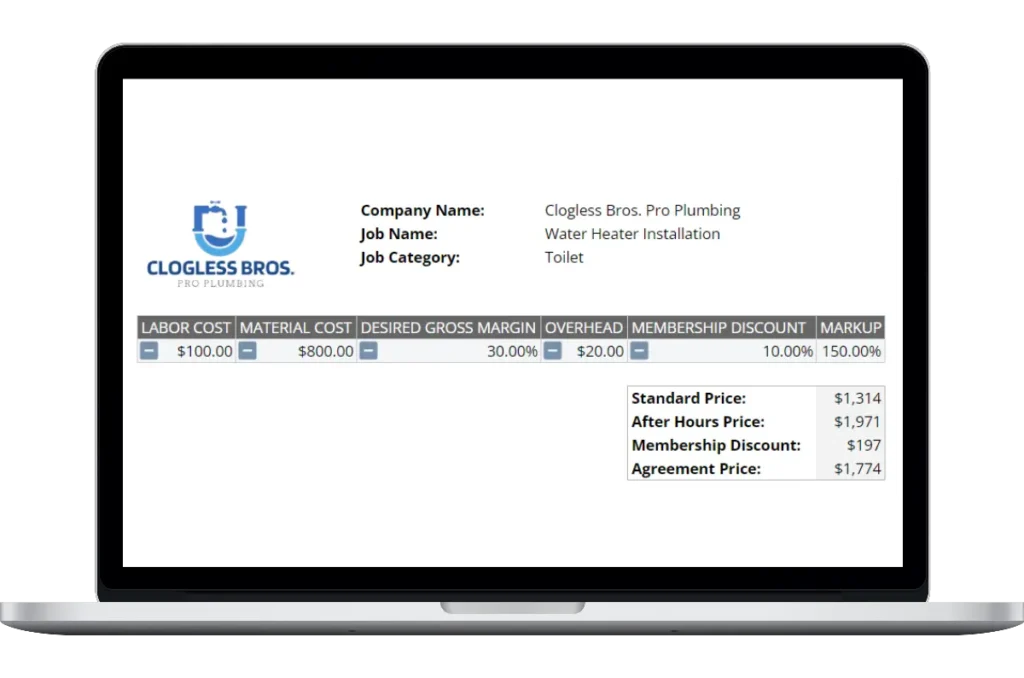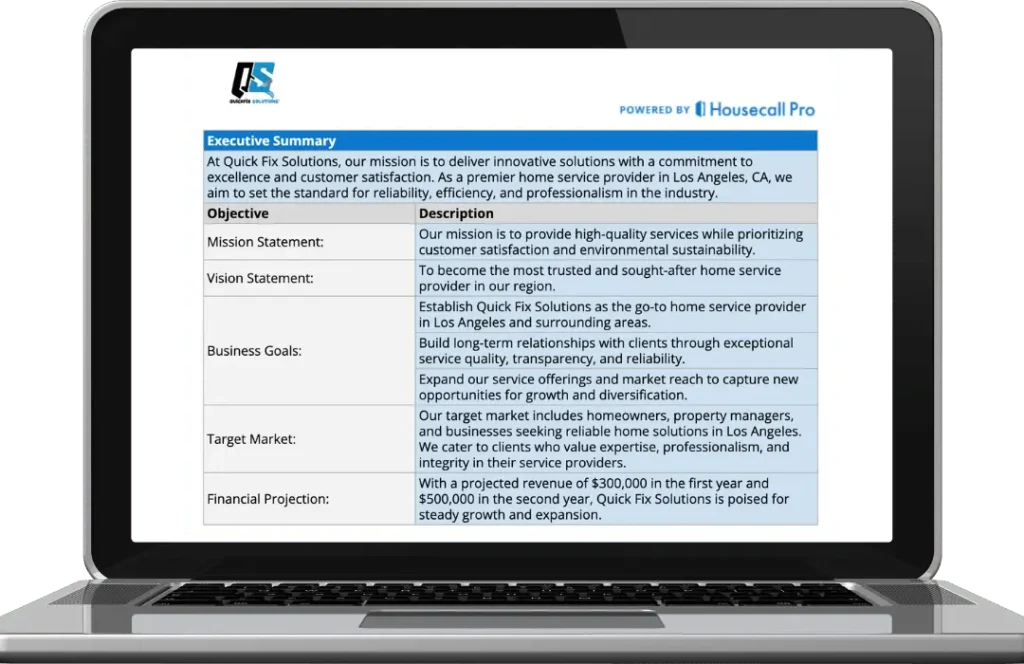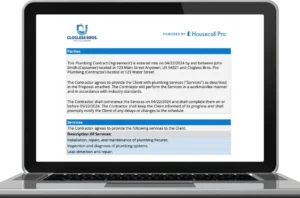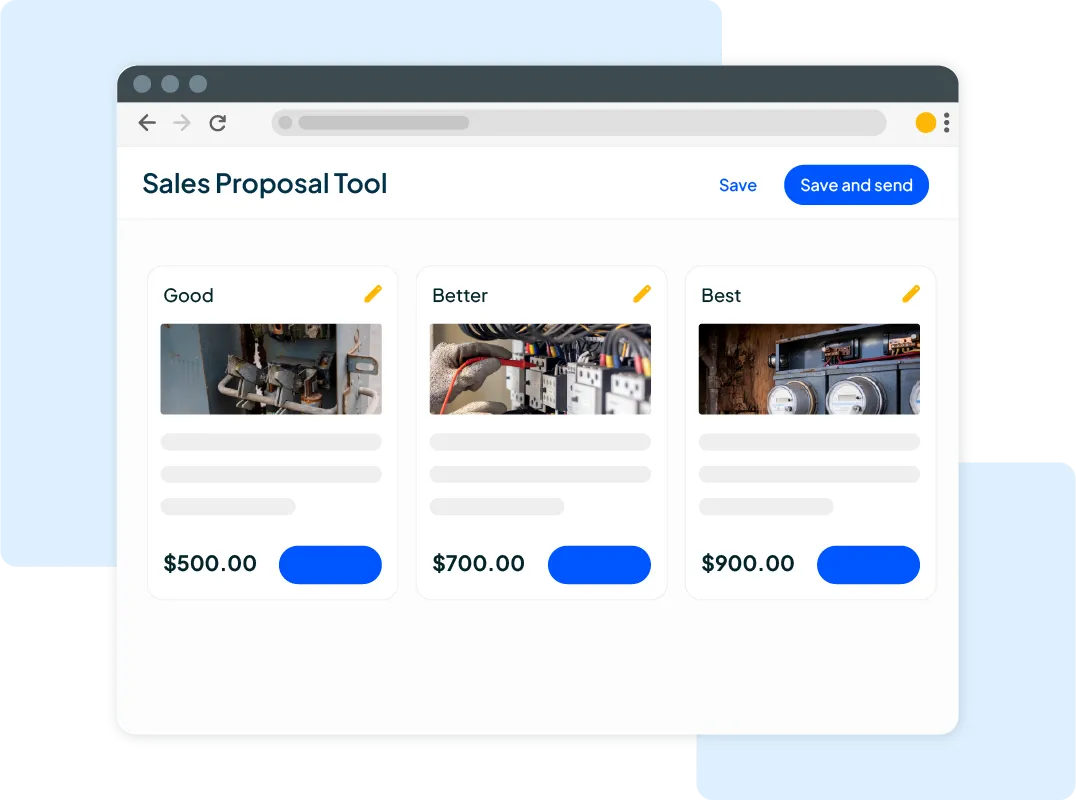Want to win more jobs with less effort?
Grow your business and send quick quotes with our home service software.

Want to see your potential revenue?
See what businesses like yours earn with Housecall Pro in 1 - 2 minutes.

When you decide to start a business, you don’t just jump into it without a plan. In fact, the most successful business owners take the time to do their due diligence, creating a business plan that outlines how their business will operate, who their target audience is, how they’ll reach them, and the products and services that they will offer.
If you are thinking of starting a plumbing business, the process is really quite the same. You’ll need to create a business plan for a plumbing company that specifies what is unique about your business and how you’ll set yourself apart from—and ahead of—your competition.
But getting started can be challenging. Many entrepreneurs looking to get into the business plan know what they want to do, but they’re not sure how to document their thoughts. In this article, we’ll provide you with everything you need to know to create a successful and lucrative plumbing company business plan.
Table of Contents
What is a Plumbing Business Plan?

A business plan, whether you are creating a plumbing business plan or one for any other business, is designed to capture your approach for the business. It’s where you document the relevant research that you have done when ideating what you will offer and who your target audience is.
For example, having a clear business plan can provide the direction and clarity needed to stay on track. A well-crafted plan allows you to anticipate potential challenges and think through the solutions before they arise. It also helps you understand your market and competition better, which is key to positioning your services in a way that resonates with your target audience. Additionally, a business plan can make it easier to secure funding or investment, as it gives potential investors a transparent view of your goals and the approach you plan to take to achieve them.
Why Do You Need a Plumbing Business Plan?
Depending on the business structure you select, you may be required to present a business plan to the state where your company will do business, to get your business license. You may also need a business plan to get a small business loan or the investment funds needed to get your business off the ground.
But aside from those endeavors—getting your business license and securing funding—your business plan can also help keep you organized, especially in that first year of business. Why? A key component of your business plan is a financial analysis that considers your list of services, pricing, how much you’ll spend on marketing and advertising, what you’ll spend on overhead costs and staffing, etc.
You won’t want to move your business forward if your math and financial goals put you in the red. But, if it puts you in the black, you’re ready to get started, but you’ll want to make sure you don’t stray outside of the lines too much. If you do, you can find yourself strapped for cash. And trust us, since about 82% of small businesses fail due to cash flow challenges, you want to do everything you can not to fall into that trap.
So, with that, let’s take a look at the key components of your business plan and why they are so important.
What’s Included in a Business Plan for a Plumbing Contractor?
Most business plans follow a tried-and-true format that includes the key things you need to consider when preparing to go into business. So, a business plan for plumbing may look very similar from an outline perspective to a business plan for another service business. That said, the key is to make sure your business plan is as specific as possible to how you will do business and what will set you apart from the competition when solving the identified needs of your customers.
For inspiration, you can refer to business plan examples to understand how others have structured their plans for similar services, or you can simply use an AI-powered business plan generator to create an AI business plan and get more ideas.
In the sections to follow, we’ll share the key components of a plumbing contractor business plan.
1. Executive Summary
The first section of your business plan is the executive summary. In this part, you’ll summarize what your plumbing business will do, who it will serve, and what sets it apart from competitors. Think of the executive summary as your chance to capture the reader’s attention and convey the purpose and promise of your business. Also, think of this as your opportunity to sell to investors and explain why they might want to support your business.
To that end, this section is also an important tool if you’re seeking funding or support. Investors or partners may look at the executive summary to quickly understand your goals, giving them a glimpse of your business’s value to the market. Keep it concise but informative, as it’s the foundation that encourages readers to explore the rest of your business plan with interest.
Helpful hint: Write your executive summary last. Though it comes at the beginning of your plan, this is where you will want to summarize the key points that your readers and investors will find later when they look through each section.
2. Business Description
Next up is your business description. And, no, simply indicating that you are a plumbing business will not suffice. You want to go into further detail here, writing a few paragraphs to a full page describing the type of plumbing company you’re starting.
In this section, you’ll paint a complete picture of your plumbing business, including what services you’ll offer and the specific problems you aim to address for your customers. Describe the type of plumbing work you specialize in—whether residential, commercial, or a combination of both—and outline any specific expertise or methods that set you apart.
Additionally, provide context about the industry, including trends or challenges that make your business relevant. It’s helpful to include details about your business structure, location, and target market to show a clear understanding of where you’ll operate and who your ideal clients are. This section is all about defining your business in a way that establishes its identity and value within the plumbing industry.
3. Market Research and Analysis
Have you ever watched the television series Shark Tank? In each show, small business owners present their businesses to a panel of wealthy and highly successful investors, sharing a pitch about their business and why these investors want to invest in them.
Almost every time, one of the “sharks” will ask the business owner about the market they are going after, whether or not market share is already saturated with that same product or service, and how they will differentiate themselves from the competition. To successfully answer these questions, business owners must have done their homework.
Market research and analysis involves gathering information about the industry you’re entering, understanding your ideal customers, and studying competitors to see what they offer and where opportunities lie. This part of your business plan will help you pinpoint your target audience, identify customer needs, and understand pricing and service expectations. You’ll also analyze competitors to find gaps in the market or unmet needs your business can fulfill.
As we shared earlier, in Shark Tank, the “sharks” often ask if there’s a demand for the product and how well competitors are meeting that demand. To confidently answer those questions, you need a clear picture of the market landscape and a plan to differentiate yourself. Strong market analysis shows you’re not just jumping into business on a whim but are making strategic decisions based on facts and trends.
4. SWOT Analysis
Once you have conducted your market research and analysis, you’ll have the data points you need to create a SWOT analysis. SWOT stands for the following:
- S – Strengths: The qualities that give your business a competitive edge, such as specialized skills, strong customer service, or unique offerings.
- W – Weaknesses: Areas where your business may face challenges, like limited experience, smaller budgets, or less brand recognition.
- O – Opportunities: External factors or trends that your business can leverage to grow, such as rising demand for certain services or new developments in technology.
- T – Threats: Potential obstacles outside of your control, such as economic shifts, new competitors, or regulatory changes that could impact your business.
Every business has its own mix of strengths, weaknesses, opportunities, and threats. If your SWOT analysis is all strengths, you may have overlooked some potential challenges or market gaps. A balanced SWOT analysis reflects an honest look at your business and market.
5. Services and Pricing Strategy

When you did your market research and analysis, you likely looked at the competition in your area to see what services they offer and how they are priced. This information can give you a baseline for what customers are used to paying and can help you determine the appropriate price. Unless your business strategy is to undercut all of the competitors—something we do not recommend—your prices should likely fall right where your competitors sit.
Here are some of the basic services you might want to include in your price list.
- Leak Detection and Repair: Identify and repair leaks in pipes, faucets, or fixtures.
- Drain Cleaning: Clear clogs and buildup in sinks, showers, and main sewer lines.
- Toilet Repair and Installation: Fix or replace toilets, including flange repairs and seal replacements.
- Water Heater Services: Installation, repair, and maintenance for tankless and traditional water heaters.
- Pipe Installation and Repair: Replace old pipes or install new pipes for remodels or expansions.
- Fixture Installation: Install new faucets, sinks, showers, and other fixtures.
- Garbage Disposal Services: Repair or replace faulty garbage disposals.
- Sump Pump Services: Install and maintain sump pumps to prevent basement flooding.
- Backflow Testing and Prevention: Inspect and install backflow prevention devices.
- Emergency Plumbing Services: 24/7 service for urgent repairs and issues.
Though the above list is intended to help you get started—by no means should it be the end all, be all—the key here is differentiation. Customers will appreciate a plumbing service provider who has competitive prices but goes the extra mile or offers a few convenient add-on services that the competitors don’t. Be thoughtful in this section, too, as this is where you are going to make your money. Price yourself too low, and those cash flow issues we mentioned before might become your reality. Price yourself too high, and your business may never gain any traction.
Download for free: Plumbing Price List Template, Plumbing Flat Rate Pricing Template
6. Marketing Plan
You know that famous movie with Kevin Costner, Field of Dreams, with the famous quote, if you build it, they will come? Well, that might work in the movies, especially where there is a supernatural undertone, but it doesn’t work in real life. You can’t simply start a business and expect customers to find you. You need to make an effort to get in front of them where they are, and you need to be there when they are looking.
This is where marketing and advertising come into play and why your marketing plan is so important. Most small businesses spend between 5% to 10% of their revenue on marketing and advertising efforts. So, you should plan for this in your financial analysis. And those efforts will include marketing ideas such as:
- Website: Build a user-friendly website so prospective customers can find you when they need your products and services.
- Local SEO: Optimize your website to appear in local search results when potential customers search for plumbing services nearby. This includes setting up and maintaining a Google Business Profile and gathering positive customer reviews. Helpful hint: Don’t go for reviews just to get reviews. Customers can see the truth behind fake reviews. So, only ask for reviews from real customers and those you have provided plumbing services to.
- Social Media Marketing: Share helpful tips, plumbing insights, and project photos on platforms like Facebook and Instagram to connect with your community and build trust.
- Online Advertising: Run targeted ads on Google or social media platforms to reach specific demographics and people actively searching for plumbing services.
- Email Marketing Campaigns: Send regular emails to past and prospective clients with maintenance tips, seasonal plumbing reminders, and exclusive offers to keep your business top-of-mind.
- Referral Program: Encourage satisfied customers to refer friends and family by offering discounts or rewards for each referral. And be sure to advertise this program on your website.
- Networking with Local Businesses: Build relationships with related businesses, like real estate agents and property managers, who might recommend your services to their clients.
Free Book Download: The Ultimate Guide to Running a Profitable Plumbing Business
7. Financial Plan
This part of your plan is where the rubber meets the road, so to speak. As we said before, if your financial plan is in the red and doesn’t show signs of getting into the black pretty quickly, you’re likely doomed for failure.
Think of your financial plan as a detailed roadmap that covers your projected revenue, expenses, and profitability over a one- to three-year period. This section should outline anticipated costs for equipment, supplies, marketing, payroll, and any unexpected expenses that could arise while running a plumbing business. To get an accurate picture of these costs, creating a monthly budget and comparing it to expected revenue will be helpful.
Your financial plan should also include a revenue projection, showing how much you expect to earn each quarter. A service price calculator can be a useful tool here, helping you set fair prices while covering your costs—just make sure that earlier section about your services and pricing aligns with what you have here.
Tracking these projections in grids and charts is a must, as it allows you to observe trendlines and make adjustments as needed. Hiring an accountant can be a wise choice for setting up these charts and forecasts, making sure you’re working with realistic numbers and planning for the long-term success of your plumbing business.
8. Operations and Management Plan
The operations and management plan outlines the day-to-day logistics and organizational structure of your plumbing business. This section describes the team structure, roles, and responsibilities, detailing who will manage key areas like customer service, scheduling, field operations, and finances. You’ll want to include any hiring plans and training or certifications needed to build a knowledgeable team.
Additionally, this part of the business plan should outline the processes you’ll follow for scheduling, job tracking, inventory management, and quality control. It helps to specify any software or tools that will help keep operations on track, such as scheduling apps or project management systems.
A clear operations plan allows you to stay organized, which is super important for customer satisfaction. Plus, it’s what will help your business grow over time.
9. Appendix
The appendix is where you can add supporting documentation that aligns with the core sections of your business plan. For example, you might include copies of any certifications, licenses, or permits required to operate your plumbing business legally. Additionally, this is a good place for the resumes of key team members, which can highlight their experience and skills, adding credibility to your management team.
If you have completed any detailed market research reports, graphs, or charts, they can also go here to back up the information in your market analysis section. You might also add service agreements or partnership letters demonstrating relationships with your preferred suppliers or vendors.
Get In Touch: 858-842-5746
Let us earn your trust
On average, Pros increase monthly revenue generated through Housecall Pro by more than 35% after their first year.
See plan options and feature breakdown on our pricing page.
How to Write a Plumbing Business Plan
Now that you know what goes into a plumbing business plan, let’s answer that lingering question for you about how to create a plumbing business plan. But before we do that, let’s align on some basic things here. The first thing to know is that writing a business plan does not happen overnight. The research phases might take several days or weeks. Then, you need to organize all that insight into coherent statements that you, investors, and other interested parties will understand.
So, be sure to plan ahead for this process.
Step 1: Gather Market Research & Industry Data
Begin by collecting comprehensive market research and data on the plumbing industry. This research phase involves understanding current trends, customer needs, and pricing norms.
Look into local demand for plumbing services and find out what customers value most. Research also helps you identify target demographics, common challenges in the industry, and seasonal demand shifts.
Step 2: Define Your Target Market and Services
Next, outline who your ideal customers are and what specific services you will provide. Are you focusing on residential plumbing, commercial projects, or specialized services like emergency repair? Clarifying your target market and services will allow you to tailor your messaging and operational plans to meet their needs.
Step 3: Analyze Your Competition
Studying your competition reveals how your business can stand out. Look into their strengths, weaknesses, and market positioning. Tools like Earnest Analytics, Ahrefs, Sprout Social, and Morning Consult Pro can help you analyze competitor performance and customer sentiment. By identifying gaps in their services, you can highlight your unique strengths and position your plumbing business to meet unmet needs in the market.
Step 4: Develop Your Marketing and Sales Strategies
Your marketing and sales plan outlines how you’ll reach customers and attract business. Think about which channels, such as social media, local SEO, or referral programs, will resonate most with the customers you are trying to reach. For example, today’s consumers spend a lot of time on social media—about 143 minutes per day—so make social media a key part of your marketing plan. And, when people have a plumbing emergency, they’re going to go right to Google to search plumbers near me. So, your strategy needs to make sure your business shows up at the top of those search results.
Consider what makes your services valuable and craft messaging that communicates this to potential clients. Additionally, plan any sales tactics, promotions, or loyalty programs that could encourage repeat business and referrals.
Step 5: Create Financial Projections
Map out financial projections for your business, estimating revenue, expenses, and profitability over the next one to three years. Include expected costs, such as payroll, equipment, and marketing expenses, and create a realistic revenue forecast. Financial projections can help you understand cash flow needs and give investors or lenders confidence in your business’s potential for success.
Step 6: Write Your Executive Summary Last
Once the other sections are complete, it’s time to write your executive summary. This section is an overview that highlights your business’s main goals and what makes it unique. As we suggested earlier, writing it last lets you summarize the details you’ve outlined throughout the plan. And, it saves you time when deciding what to include in each section, what should go in the appendix, and what to share here.
Remember, the executive summary is your introduction to potential partners and investors, so keep it engaging with the information they are going to want to see. And, don’t skimp out on this section either. Most executive summaries are between one and four pages in length.
Grab Our Free Plumbing Business Plan Template

Though writing a business plan takes time, it doesn’t have to be overly complicated. By doing your research upfront, especially understanding the unmet needs of your target audience and building products and services accordingly, you can build a highly successful plumbing business. With all this said, you don’t need to build a business plan from scratch. At Housecall Pro, we offer free business plan templates for plumbers. Download one of our free templates today. And when you are ready, be sure to try out our free 14-day trial of plumbing business software. We’re here to help your business scale and grow.







